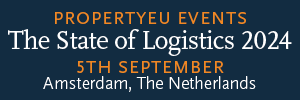Significant structural shifts affecting the logistics industry are changing the landscape of location demand, writes Tobias Kassner, head of research at Garbe Industrial Real Estate.
The end of the Cold War acted like a catalyst for the liberal international economic order and free world trade. Asian countries, especially China, beckoned with a seemingly inexhaustible supply of cheap labour and became the world’s extended workbench. The location benefits, augmented by low energy costs and other perks, made many western companies move their production to China.
But the economic system of globalisation, stable over decades, is beginning to crack. In ever shorter intervals, it has suffered several blows. The first setback was increasing renationalisation tendencies in response to excessive dependencies and growing distrust of the global economic system. The return to national interests manifested itself strikingly in Brexit or an “America First” policy á la Trump.
Although these tendencies are still active, the coronavirus pandemic came into focus immediately afterwards. This had the sobering side effect of exposing the fragility of supply chains. Together with the Suez Canal disaster, this triggered the debate on whether globally distributed production is still viable. The pandemic was also not yet over when the third setback occurred. With the Russian war of aggression on Ukraine, supply chain problems intensified.
With no end in sight, the war also triggered a rethink in procurement strategies, especially for energy carriers or rare resources. In turbulent times, economic hopes often rest on trade relations with China. As long as this gigantic supplier and consumer market is active, it develops enough traction to boost the global economy. But the pandemic has made this market another cause for concern. In the past, China’s economic growth took precedence. Now domestic political goals are more important, even at the expense of economic growth and further disruption of supply chains.
Re- and nearshoring potential in Europe
The pandemic has triggered a debate on reshoring or nearshoring production lines, at least on a hypothetical level. It would imply a paradigmatic shift. The pandemic alone would not have been reason enough. After all, there were sound reasons for relocating the production to China or other Asian markets: Labour markets at home were tightly regulated, with trade unions actively strengthening workers’ rights.
The transition to renewable energies involves long-term planning and enormous costs, impacting production. Inversely, outsourcing production created handsome margins. Pandemic-battered companies had hoped things would somehow return to normal in the medium term. Backshoring production and accepting profit cuts just seemed unrealistic.
But after four successive setbacks, there are signs that manufacturers are changing tack. They clearly prioritise autonomy and security now. In production, this has prompted a “China-plus-one” approach. It supplements a Chinese manufacturing site with one or more alternatives. These may also be located in Asia. The “plus-one” destination could also be in Europe. The restructuring efforts are not yet reflected in statistics. But the number of examples is growing.
The ongoing structural changes have prompted Garbe to study the issue in depth. The study investigated which factors can lead to additional demand for logistics and industrial space and where this demand is most likely to be reflected in Europe.
The shortening of supply chains outlined above can be reflected in an increased demand for industrial space and, due to upstream and downstream processes, also for logistics space. In some cases, additional demand can also be expected in the core markets of the classic “blue banana” industrial areas such as Germany, France and Great Britain. In other words, countries that used to primarily outsource and are now bringing production back (re-shoring). Due to the high price structures (wages, energy) in these countries as well as other facets, a relocation back to cheaper markets, especially in Eastern Europe, but also in neighbouring countries (e.g. Turkey) will also be a frequent option (near-shoring).
Until recently, the maxim of just-in-time production and reducing warehousing to the absolute minimum applied especially in the automotive industry. This took its revenge in the pandemic, but also in the Ukraine war. Now the production lines are standing still more and more often. To prevent this from happening again, more and more companies are rethinking and building redundant supply chains. Reactivating warehousing is also being put on the agenda. Because production downtime is more cost-intensive than warehousing.
The storage debate
Empty shelves in supermarkets were a novelty for most people in Western Europe. Brexit and the pandemic in particular highlighted the systemic relevance of logistics. This includes increased stockholding. However, this does not only apply to consumption-oriented population supply, but also to disaster preparedness. Strategic stocks of medicines, food and comparable goods were quickly used up, if they were still available at all. Countermeasures are to be taken here and strategic reserves built up. Storage areas are needed for this purpose.
The pandemic has developed as a booster for the changed consumer behaviour and has enormously increased the e-commerce order volume on the internet. For this purpose, massive logistics space was needed and also newly created. Shortly before the outbreak of the Ukrainian war, the population was on the verge of making consumption expenditures that had been pent up during the pandemic. However, high inflation and the uncertain outlook in wartime led to a slowdown in consumer spending, so that overcapacity is currently being felt in some areas. But this is only a snapshot.
Basically, the saturation level in e-commerce has not yet been exhausted. There is still a lot of additional demand.
The current situation is characterised more by a wait-and-see attitude. However, there are indications that additional demand for industrial and logistics space in Europe can be expected in the medium term for the reasons mentioned. The question of how high this demand will be can hardly be estimated validly at present. However, it can be determined approximately where the potential is comparatively high or rather low. The adjacent map shows the total potential for all the drivers listed above.




































